

Classroom Catalysts: Inventive Teachers Ignite Self-Guided Learning. You've heard the old chestnut: "Those who can, do.
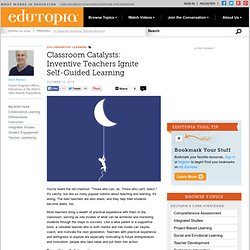
Those who can't, teach. " It's catchy, but like so many popular notions about teaching and learning, it's wrong. The best teachers are also doers, and they help their students become doers, too. Most teachers bring a wealth of practical experience with them to the classroom, serving as role models of what can be achieved and mentoring students through the steps to success.
Like a wise parent or a supportive boss, a versatile teacher who is both mentor and role model can inspire, coach, and motivate the next generation. Everything Is Interesting Gever Tulley is one such teacher-catalyst. For example, the arc on rulers was designed to illustrate the value of precision and accuracy. For the second phase, ten sixth-through-ninth graders proposed to improve access to an unused part of their classroom by building a bridge between the mezzanine and second floor.
Solving Problems and Puzzles Gever is himself an explorer in the field of teaching. The Power of "I Don't Know" The role of teaching has evolved.
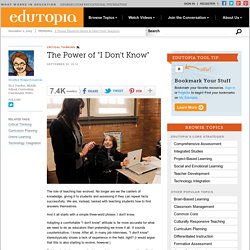
No longer are we the carriers of knowledge, giving it to students and assessing if they can repeat facts successfully. We are, instead, tasked with teaching students how to find answers themselves. And it all starts with a simple three-word phrase: I don't know. Adopting a comfortable "I don't know" attitude is far more accurate for what we need to do as educators then pretending we know it all.
It sounds counterintuitive, I know. But in school where every client is a work in progress, we need to cultivate a certain excitement in not knowing something. Changing Attitudes At the start of each year, I have to train students that I will not be feeding them answers. Rather, I will teach them how to develop questions. Improving Executive Function: Teaching Challenges and Opportunities. The High Cost of Over-Packed Curriculum Standards For 21st century success, students will need skill sets far beyond those that are mandated in the densely packed standards -- and that's evaluated on bubble tests.

In the near future, success will depend on accelerated rates of information acquisition. And we need to help students develop the skill sets to analyze new information as it becomes available, to flexibly adapt when facts are revised, and to be technologically fluent (as new technology becomes available). Success will also depend upon one's ability to collaborate and communicate with others on a global playing field -- with a balance of open-mindedness, foundational knowledge, and critical analysis skills so they can make complex decisions using new and changing information.
We are painfully aware that the educational model has not changed to accommodate the exponentially increasing amount of information pertinent to students. Resources and Downloads for Teaching Critical Thinking. Tips for downloading: PDF files can be viewed on a wide variety of platforms -- both as a browser plug-in or a stand-alone application -- with Adobe's free Acrobat Reader program.
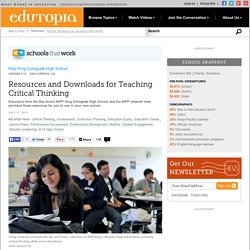
Click here to download the latest version of Adobe Reader. Click on any title link below to view or download that file. Resources On This Page: Lesson Plans & Rubrics. Three Steps to Critical Thinking. Edward Charles Francis Publius de Bono is a bona fide genius.
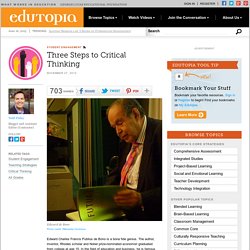
The author, inventor, Rhodes scholar and Nobel prize-nominated economist graduated from college at age 15. In the field of education and business, he is famous for originating the term lateral thinking. In his spare time, he also wrote Six Thinking Hats and several other books on creativity. Of all his contributions to the field of education, there is one critical thinking method that I use in classes more than any other: the PMI, a brainstorming model built on the categories of plus, minus and interesting.
Creative and Critical Thinking Can Be Taught De Bono repeats throughout his writing that critical and creative thinking can be taught. Teaching scenario #1 When you ask a volunteer from your AP English class to analyze the Gettysburg Address, not one hand raises. Teaching scenario #2 Teaching scenario #3. Critical Thinking Toolbox: How to Brainstorm. Brainstorming is an essential part of critical thinking and a tool that people use to invent an idea, find a solution to a problem, or answer a question.
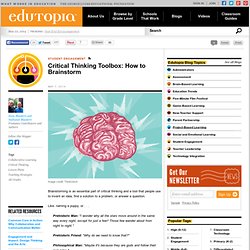
Like: naming a puppy, or . . . Class Discussion to Encourage Critical Thinking: Resources for Grades 9-12. About Socratic Seminars Socratic Seminars: Patience & Practice <img class="media-image media-element file-content-image" src="/sites/default/files/styles/content_image_breakpoints_theme_edutopia_desktop_1x/public/content/73/video.gif?
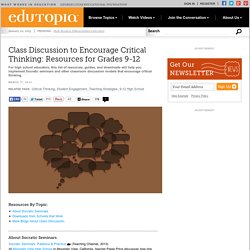
Itok=pmoQLTDv" alt="" /> (Teaching Channel, 2013) At Mountain View High School in Mountain View, California, teacher Paige Price discusses how she uses Socratic Seminars in her classroom to address the question, “What’s the purpose of poetic language?” Make sure to check out the supporting materials related to the featured activities, including scoring and student preparation guides.